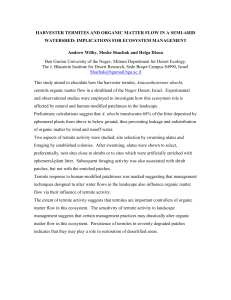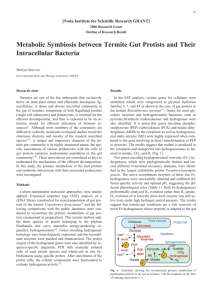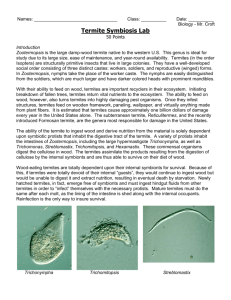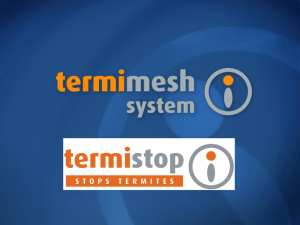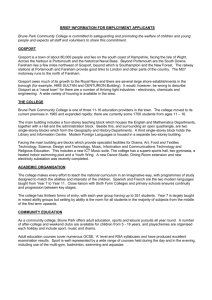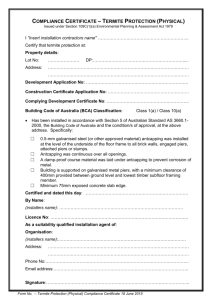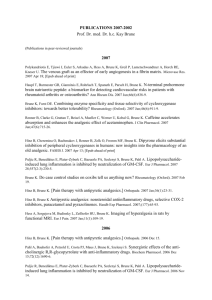Endomicrobia: intracellular symbionts of termite gut flagellates
advertisement
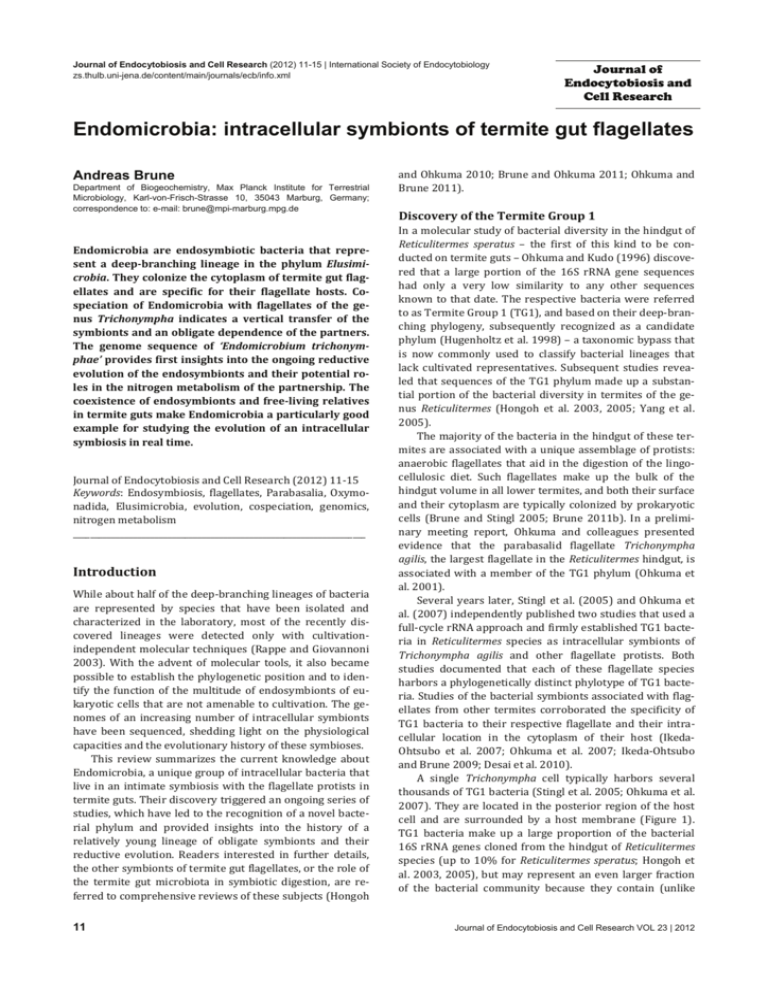
Journal of Endocytobiosis and Cell Research (2012) 11-15 | International Society of Endocytobiology zs.thulb.uni-jena.de/content/main/journals/ecb/info.xml Journal of Endocytobiosis and Cell Research Endomicrobia: intracellular symbionts of termite gut flagellates Andreas Brune Department of Biogeochemistry, Max Planck Institute for Terrestrial Microbiology, Karl-von-Frisch-Strasse 10, 35043 Marburg, Germany; correspondence to: e-mail: brune@mpi-marburg.mpg.de Endomicrobia are endosymbiotic bacteria that repre­ sent a deep­branching lineage in the phylum Elusimi­ crobia. They colonize the cytoplasm of termite gut flag­ ellates and are specific for their flagellate hosts. Co­ speciation of Endomicrobia with flagellates of the ge­ nus Trichonympha indicates a vertical transfer of the symbionts and an obligate dependence of the partners. The genome sequence of ‘Endomicrobium trichonym­ phae’ provides first insights into the ongoing reductive evolution of the endosymbionts and their potential ro­ les in the nitrogen metabolism of the partnership. The coexistence of endosymbionts and free­living relatives in termite guts make Endomicrobia a particularly good example for studying the evolution of an intracellular symbiosis in real time. Journal of Endocytobiosis and Cell Research (2012) 11‐15 Keywords: Endosymbiosis, flagellates, Parabasalia, Oxymo‐ nadida, Elusimicrobia, evolution, cospeciation, genomics, nitrogen metabolism ____________________________________________________________________ Introduction While about half of the deep‐branching lineages of bacteria are represented by species that have been isolated and characterized in the laboratory, most of the recently dis‐ covered lineages were detected only with cultivation‐ independent molecular techniques (Rappe and Giovannoni 2003). With the advent of molecular tools, it also became possible to establish the phylogenetic position and to iden‐ tify the function of the multitude of endosymbionts of eu‐ karyotic cells that are not amenable to cultivation. The ge‐ nomes of an increasing number of intracellular symbionts have been sequenced, shedding light on the physiological capacities and the evolutionary history of these symbioses. This review summarizes the current knowledge about Endomicrobia, a unique group of intracellular bacteria that live in an intimate symbiosis with the flagellate protists in termite guts. Their discovery triggered an ongoing series of studies, which have led to the recognition of a novel bacte‐ rial phylum and provided insights into the history of a relatively young lineage of obligate symbionts and their reductive evolution. Readers interested in further details, the other symbionts of termite gut flagellates, or the role of the termite gut microbiota in symbiotic digestion, are re‐ ferred to comprehensive reviews of these subjects (Hongoh 11 and Ohkuma 2010; Brune and Ohkuma 2011; Ohkuma and Brune 2011). Discovery of the Termite Group 1 In a molecular study of bacterial diversity in the hindgut of Reticulitermes speratus – the first of this kind to be con‐ ducted on termite guts – Ohkuma and Kudo (1996) discove‐ red that a large portion of the 16S rRNA gene sequences had only a very low similarity to any other sequences known to that date. The respective bacteria were referred to as Termite Group 1 (TG1), and based on their deep‐bran‐ ching phylogeny, subsequently recognized as a candidate phylum (Hugenholtz et al. 1998) – a taxonomic bypass that is now commonly used to classify bacterial lineages that lack cultivated representatives. Subsequent studies revea‐ led that sequences of the TG1 phylum made up a substan‐ tial portion of the bacterial diversity in termites of the ge‐ nus Reticulitermes (Hongoh et al. 2003, 2005; Yang et al. 2005). The majority of the bacteria in the hindgut of these ter‐ mites are associated with a unique assemblage of protists: anaerobic flagellates that aid in the digestion of the lingo‐ cellulosic diet. Such flagellates make up the bulk of the hindgut volume in all lower termites, and both their surface and their cytoplasm are typically colonized by prokaryotic cells (Brune and Stingl 2005; Brune 2011b). In a prelimi‐ nary meeting report, Ohkuma and colleagues presented evidence that the parabasalid flagellate Trichonympha agilis, the largest flagellate in the Reticulitermes hindgut, is associated with a member of the TG1 phylum (Ohkuma et al. 2001). Several years later, Stingl et al. (2005) and Ohkuma et al. (2007) independently published two studies that used a full‐cycle rRNA approach and firmly established TG1 bacte‐ ria in Reticulitermes species as intracellular symbionts of Trichonympha agilis and other flagellate protists. Both studies documented that each of these flagellate species harbors a phylogenetically distinct phylotype of TG1 bacte‐ ria. Studies of the bacterial symbionts associated with flag‐ ellates from other termites corroborated the specificity of TG1 bacteria to their respective flagellate and their intra‐ cellular location in the cytoplasm of their host (Ikeda‐ Ohtsubo et al. 2007; Ohkuma et al. 2007; Ikeda‐Ohtsubo and Brune 2009; Desai et al. 2010). A single Trichonympha cell typically harbors several thousands of TG1 bacteria (Stingl et al. 2005; Ohkuma et al. 2007). They are located in the posterior region of the host cell and are surrounded by a host membrane (Figure 1). TG1 bacteria make up a large proportion of the bacterial 16S rRNA genes cloned from the hindgut of Reticulitermes species (up to 10% for Reticulitermes speratus; Hongoh et al. 2003, 2005), but may represent an even larger fraction of the bacterial community because they contain (unlike Journal of Endocytobiosis and Cell Research VOL 23 | 2012 Endomicrobia, Brune A many other bacteria) only a single copy of the rrn operon (Hongoh et al. 2008a). Endomicrobia are a class of the Elusimicrobia phylum Based on their host specificity and their intracellular loca‐ tion, Stingl et al. (2005) suggested the candidate phylum ‘Endomicrobia’ for the deep‐branching clade of TG1 bacte‐ ria, which at that time consisted exclusively of clones ob‐ tained from the guts of phylogenetically lower termites and wood‐feeding cockroaches of the genus Cryptocercus, and proposed ‘Candidatus Endomicrobium trichonymphae’ and ‘Candidatus Endomicrobium pyrsonymphae’ for the symbionts of the respective flagellate lineages. However, subsequent screening of public databases for 16S rRNA gene sequences for TG1 bacteria yielded increas‐ ing numbers of uncultured bacteria from other environ‐ ments that fell within the radiation of the Endomicrobia (Herlemann et al. 2007, Geissinger et al. 2009). Presently, the phylum consists of several deep‐branching lineages that occur either in the intestinal tracts of insects and mammals or in habitats such as soils, sediments, and contaminated aquifers (Figure 2). The first cultivated representative, Elusimicrobium minutum, has been isolated from the gut of a scarab beetle larva (Geissinger et al. 2009). It is an ultramicrobacterium that falls into a large cluster of bacte‐ ria colonizing the digestive tracts of insects and verte‐ brates. Based on the species description, Geissinger et al. (2009) proposed Elusimicrobia as taxonomic name for the TG1 phylum, and demoted the Endomicrobia lineage to the class level. Figure 1: (A) Photomicrograph of a Trichonympha sp. from the gut of Zootermopsis nevadensis. (B) Fluorescence in situ hybridization of bacterial symbionts hybridized with rRNA‐targeted oligonucleotide probes. Endomicrobia appear in yellow, other bacteria in green. (C) Transmission electron micrograph of ‘Endomicrobium trichonymphae’ cells in an ultrathin section of Trichonympha collaris. The cytoplasm of the flagellate contains glycogen granules (g) and rough endoplasmatic recticulum (er); the membrane surrounding the endosymbiont forms tube‐like elongations at the cell poles (arrowhead). Images: W. Ikeda‐Ohtsubo (A,B), J. Strassert (C). Host specificity and cospeciation Flagellates of the genus Trichonympha are widespread among termites of different families. The clustering of Endomicrobia phylotypes retrieved from these flagellates suggested a common ancestry of the symbionts. Cospeciation analysis revealed an almost perfect congru‐ ence of the phylogenies of Endomicrobia symbionts and their Trichonympha hosts, confirming the monophyletic nature of ‘E. trichonymphae’ (Ikeda‐Ohtsubo and Brune 2009). Different lineages of Endomicrobia were found to colo‐ nize a variety of other termite gut flagellates, including both parabasalids and oxymonadid species, which belong to different phyla. The colonization patterns are quite com‐ plex, and the phylogeny of the symbionts is often not in agreement with that of their hosts, suggesting that multiple acquisitions or horizontal transfers of symbionts between flagellates may have occurred (Ikeda‐Ohtsubo et al. 2007; Journal of Endocytobiosis and Cell Research VOL 23 | 2012 Ohkuma et al. 2007; Desai et al. 2010). Moreover, the num‐ ber of symbionts per cell strongly varies between different flagellate lineages, and colonization may be sparse or even inconsistent. In the case of the flagellate genus Dinenympha, Endomicrobia were detected only in one or two species of several congeneric host populations, whereas those report‐ edly associated with other symbionts were free of Endomicrobia (Ohkuma et al. 2007). Interestingly, Endomicrobia are often not the only spe‐ cies of symbionts present in a flagellate host cell. Different regions of the cytoplasm may be colonized by two or more populations of endosymbionts, and also one or more ectosymbionts may be present. These symbionts are from other bacterial phyla, and each population occupies a dif‐ ferent region of the host cell. While the cells of ‘E. trichonymphae’ are typically located in the posterior part of the host cell, Trichonympha agilis possesses also a second type of bacterial symbiont of the genus Desulfovibrio locat‐ 12 Endomicrobia, Brune A ed in the anterior part of the cell (Sato et al. 2008). In other flagellate lineages, it is not uncommon to find the simulta‐ neous colonization by Endomicrobia endosymbionts and ectosymbiotic Bacte‐roidales or Spirochaetes (e.g., Strassert et al. 2009, 2010; Desai et al. 2010). It has been speculated that these secondary symbionts complement or substitute functions provided by Endomicrobia. Figure 2: Phylogenetic tree of Endomicrobia and their position within the Elusimicrobia phylum. Only the major lineages and their respective habitats are shown. The analysis is based on an alignment of near‐full length 16S rRNA genes. The scale bar indicates 0.1 substitutions per site, the bullets indicate bootstrap support (o, >70%; •, >95%). The shaded area marks the assumed (possibly multiple) events of symbiont acquisition by the different flagellate lineages. The shaded branch contains Elusimicrobium minutum, the only cultivated member of the phylum. Based on data of Geissinger et al. (2009) and Ikeda‐Ohtsubo et al. (2010). Evolutionary origin and free­living relatives The monophyly of the entire Endomicrobia class is well supported, but the origin of the insect lineage is obscure, particularly because of the sister group relationship to a clade of sequences from the bovine rumen (Ohkuma et al. 2007). It is also not clear at what point in the evolutionary history the specific associations of termite gut flagellates and Endomicrobia have been established. Termites are considered social cockroaches (Inward et al. 2007; Trautwein et al. 2012), and numerous lineages of gut bacte‐ ria are common between termites and the blattid cockroach Shelfordella lateralis (Schauer et al. 2012). The gut flagel‐ lates were probably acquired by a common ancestor of termites and Cryptocercidae only than 130 million years ago (Ohkuma et al. 2009). However, Endomicrobia are present both in cockroaches and higher termites (family Termitidae), which lost the flagellates in the course of evo‐ lution (Ohkuma et al. 2007; Ikeda‐Ohtsubo et al. 2010). This indicates that endosymbiotic Endomicrobia were 13 derived from free‐living relatives that were present already in the flagellate‐free cockroach ancestor. It is unclear whether the endosymbionts arose from a single endosymbiotic event or whether the symbionts were independently acquired by different flagellate lineages. The phylogenetic resolution of the existing dataset is insuffi‐ cient to determine the exact topology of the branches con‐ taining flagellate symbionts (Figure 2). The detection of novel phylotypes of Endomicrobia in Reticulitermes santonensis after elimination of the large flagellates and their abundant symbionts (Ikeda‐Ohtsubo et al. 2010) indicates that putatively free‐living forms are present also in lower termites. Also the Endomicrobia phylotypes ob‐ tained from the cockroach Cryptocercus punctulatus (Stingl et al. 2005; Ohkuma et al. 2007) have not yet been localized and may also represent free‐living strains. The consistent absence of Endomicrobia in the basal clades of the genus Trichonympha (Clusters II and III) has been attributed to a late establishment of Endomicrobia in this lineage of flagel‐ Journal of Endocytobiosis and Cell Research VOL 23 | 2012 Endomicrobia, Brune A lates (Ikeda‐Ohtsubo and Brune 2009), which postpones the acquisition of Endomicrobia to the ancestor of Trichonympha Cluster I, long after the establishment of the digestive symbiosis between flagellates and the dictyop‐ teran ancestor of termites and Cryptocercus cockroaches. Functional role in the symbiosis The complete genome sequence of ‘Endomicrobium trichonymphae’ strain Rs‐D17, the endosymbiont of Trichonympha agilis in Reticulitermes speratus, has been determined by Hongoh et al. (2008a). Using multiple dis‐ placement amplification, the authors amplified genomic DNA of several hundred endosymbiont cells collected by micromanipulation from a single flagellate cell, thereby avoiding the problem of genome variations or polymor‐ phisms introduced by multiple hosts. The genome of ‘E. trichonymphae’ is quite small (1.13 Mbp), and many gene functions have been lost. This is typical for endosymbionts and reflects the adaptation to the intracellular lifestyle (Klasson and Andersson 2004). The presence of numerous pseudogenes indicates that genome reduction is still ongoing (Hongoh et al. 2008a). By con‐ trast, the genome of the distantly related Elusimicrobium minutum, the only cultured representative in the Elusimicrobia phylum, is much larger (1.64 Mbp) and con‐ tains almost no pseudogenes (Herlemann et al. 2009). However, despite the considerable genome reduction typi‐ cal of obligate endosymbionts, ‘E. trichonymphae’ has re‐ tained a diversity of pathways for the biosynthesis of amino acids and vitamins that are lacking in the free‐living E. minutum. Although ‘E. trichonymphae’ possesses the capacity to synthesize 15 amino acids and various cofactors, it lacks the genes for ammonia assimilation and nitrogen fixation (Hongoh et al. 2008a), a feature that has been discovered in endosymbionts of the phylum Bacteroidetes associated with a different group of flagellates (Hongoh et al. 2008b). Based on their enormous abundance, the endosymbionts of the large gut flagellates are considered to play important roles in supplying their hosts, and thereby indirectly also the termite, with essential nutrients lacking in the lignocellulosic diet. The need for nitrogen fixation and upgrading may also be part of the driving forces behind the cospeciation of such symbionts with their flagellate hosts (Noda et al. 2007; Ikeda‐Ohtsubo and Brune 2009; Desai et al. 2010). Older work on the association of bacteria with flagel‐ lates (reviewed by Brune and Stingl 2005) had suggested that these symbionts may be responsible for the cellulolytic capacities of the flagellates. However, this can now be ex‐ cluded because the genomes of the two symbionts se‐ quenced to date do not encode for cellulases (Hongoh et al. 2008a, 2008b) and the flagellates themselves have been shown to express potent cellulases that are secreted into the digestive vacuole (e.g., Todaka et al. 2010). Conclusion and Outlook The occurrence of multiple lineages of endosymbionts and free‐living relatives among Endomicrobia provides an excellent opportunity for studying the evolutionary history and the mechanisms of reductive evolution of intracellular Journal of Endocytobiosis and Cell Research VOL 23 | 2012 symbionts. However, despite the considerable advances in the diversity of Endomicrobia, their co‐speciation with host flagellates, and their functional role in the symbiosis, the evolutionary origin of the endosymbionts is still obscure. There is a particular need for more information on the phylogeny and distribution of free‐living Endomicrobia in cockroaches and higher termites. To understand the mech‐ anisms of the reductive evolution that occurred upon asso‐ ciation with their flagellate hosts, additional genome se‐ quences are required, especially of the free‐living repre‐ sentatives. Comparative genome analysis would also give insights into the parallel evolution of isolated lineages of symbiont that are under the same selective pressure. Acknowledgement The author gratefully acknowledges funding by the Deutsche Forschungsgemeinschaft SFB‐TR1, project A9. References Brune A. (2011) Microbial symbioses in the digestive tract of lower Termites. In: Rosenberg E, Gophna U. (eds.), Beneficial Microor­ ganisms in Multicellular Life Forms. Springer, Heidelberg, pp. 3– 25. Brune A, Ohkuma M. (2011) Role of the termite gut microbiota in symbiotic digestion. In: Bignell DE, Roisin Y, Lo N. (eds.), Biology of termites: A Modern Synthesis. Springer, Dordrecht, pp. 439– 475. Brune A, Stingl U. (2005) Prokaryotic symbionts of termite gut flagellates: phylogenetic and metabolic implications of a tripar‐ tite symbiosis. In: Overmann J. (ed.) Molecular Basis of Symbiosis, Springer, Berlin, pp. 39–60. Desai MS, Strassert JFH, Meuser K, Hertel H, Ikeda‐Ohtsubo W, Radek R, Brune A. (2010) Strict cospeciation of devescovinid flagellates and Bacteroidales ectosymbionts in the gut of dry‐ wood termites (Kalotermitidae). Environ Microbiol. 12:2120– 2132. Desai MS, Brune A. (2012) Bacteroidales ectosymbionts of gut flagellates shape the nitrogen‐fixing community in dry‐wood termites. ISME J. 6:1302–1313. Geissinger O, Herlemann DPR, Mörschel E, Maier UG, Brune A. (2009) The ultramicrobacterium "Elusimicrobium minutum" gen. nov., sp. nov., the first cultivated representative of the Termite Group 1 phylum. Appl Environ Microbiol. 75:2831–2840. Herlemann DPR, Geissinger O, Brune A. (2007) The Termite Group I phylum is highly diverse and widespread in the environment. Appl Environ Microbiol. 73:6682–6685. Herlemann DPR, Geissinger O, Ikeda‐Ohtsubo W, Kunin V, Sun H, Lapidus A, Hugenholtz P, Brune A. (2009) Genomic analysis of "Elusimicrobium minutum," the first cultivated representative of the phylum "Elusimicrobia" (formerly Termite Group 1). Appl Environ Microbiol. 75:2841–2849. Hongoh Y, Deevong P, Inoue T, Moriya S, Trakulnaleamsai S, Oh‐ kuma M, Vongkaluang C, Noparatnaraporn N, Kudo T. (2005) Intra‐ and interspecific comparisons of bacterial diversity and community structure support coevolution of gut microbiota and termite host. Appl Environ Microbiol. 71:6590–6599. Hongoh Y, Ohkuma M. (2010) Termite gut flagellates and their methanogenic and eubacterial symbionts. In: Hackstein JHP. (ed.) (Endo)symbiotic Methanogenic Archaea. Springer, Heidelberg, pp. 55–79. Hongoh Y, Ohkuma M, Kudo T. (2003) Molecular analysis of bacte‐ rial microbiota in the gut of the termite Reticulitermes speratus (Isoptera; Rhinotermitidae). FEMS Microbiol Ecol. 44:231–242. Hongoh Y, Sharma VK, Prakash T, Noda S, Taylor TD, Kudo T, Sa‐ kaki Y, Toyoda A, Hattori M, Ohkuma M. (2008a) Complete ge‐ 14 Endomicrobia, Brune A nome of the uncultured Termite Group 1 bacteria in a single host protist cell. Proc Natl Acad Sci USA. 105:5555–5560. Hongoh Y, Sharma VK, Prakash T, Noda S, Toh H, Taylor TD, Kudo T, Sakaki Y, Toyoda A, Hattori M, Ohkuma M. (2008b) Genome of an endosymbiont coupling N2 fixation to cellulolysis within pro‐ tist cells in termite gut. Science. 322:1108–1109. Hugenholtz P, Goebel BM, Pace NR. (1998) Impact of culture‐ independent studies on the emerging phylogenetic view of bac‐ terial diversity. J Bacteriol. 180:4765–4774. Ikeda‐Ohtsubo W, Brune A. (2009) Cospeciation of termite gut flagellates and their bacterial endosymbionts: Trichonympha species and 'Candidatus Endomicrobium trichonymphae'. Mol Ecol. 18:332–342. Ikeda‐Ohtsubo W, Desai M, Stingl U, Brune A. (2007) Phylogenetic diversity of "Endomicrobia" and their specific affiliation with termite gut flagellates. Microbiology. 153:3458–3465. Ikeda‐Ohtsubo W, Faivre N, Brune A. (2010) Putatively free‐living 'Endomicrobia' – ancestors of the intracellular symbionts of ter‐ mite gut flagellates? Environ Microbiol. 2:554–559. Inward D, Beccaloni G, Eggleton P. (2007) Death of an order: a comprehensive molecular phylogenetic study confirms that ter‐ mites are eusocial cockroaches. Biol Lett. 3:331–335. Klasson L, Andersson SG. (2004) Evolution of minimal‐gene‐sets in host‐dependent bacteria. Trends Genet. 12:37–43. Noda S, Kitade O, Inoue M, Kawai M, Kanuka M, Hiroshima K, Hon‐ goh Y, Constantino R, Uys V, Zhong J, Kudo T, Ohkuma M. (2007) Cospeciation in the triplex symbiosis of termite gut protists (Pseudotrichonympha spp.), their hosts, and their bacterial endo‐ symbionts. Mol Ecol. 16:1257–1266. Ohkuma M, Brune A. (2011) Diversity, structure, and evolution of the termite gut microbial community. In: Bignell DE, Roisin Y, Lo N. (eds.) Biology of Termites: A Modern Synthesis, Springer, Dordrecht, pp. 413–438. Ohkuma M, Kudo T. (1996) Phylogenetic diversity of the intestinal bacterial community in the termite Reticulitermes speratus. Appl Environ Microbiol. 62:461–468. Ohkuma M, Noda S, Hongoh Y, Nalepa CA, Inoue T. (2009) Inheri‐ tance and diversification of symbiotic trichonymphid flagellates from a common ancestor of termites and the cockroach Crypto­ cercus. Proc R Soc B. 276:239–245. Ohkuma M, Noda S, Iida T, Kudo T. (2001). Phylogenetic identifica‐ tion of endosymbionts of the flagellated protists in the gut of termites. Abstracts of the 9th International Symposium on Mi‐ crobial Ecology (ISME‐9). International Society for Microbial Ecology. Geneva, Switzerland, p. 280. Ohkuma M, Sato T, Noda S, Ui S, Kudo T, Hongoh Y. (2007) The candidate phylum 'Termite Group 1' of bacteria: phylogenetic diversity, distribution, and endosymbiont members of various gut flagellated protists. FEMS Microbiol Ecol. 60:467–476. Rappe MS, Giovannoni SJ. (2003) The uncultured microbial major‐ ity. Annu Rev Microbiol. 57:369–394. Sato T, Hongoh Y, Noda S, Hattori S, Ui S, Ohkuma M. (2009) Candi­ datus Desulfovibrio trichonymphae, a novel intracellular symbi‐ ont of the flagellate Trichonympha agilis in termite gut. Environ Microbiol. 11:1007–1015. Schauer C, Thompson CL, Brune A. (2012) The bacterial commu‐ nity in the gut of the cockroach Shelfordella lateralis reflects the close evolutionary relatedness of cockroaches and termites. Appl Environ Microbiol. 78:2758–2767. Stingl U, Radek R, Yang H, Brune A. (2005) 'Endomicrobia': Cyto‐ plasmic symbionts of termite gut protozoa form a separate phy‐ lum of prokaryotes. Appl Environ Microbiol. 71:1473–1479. Strassert JFH, Desai MS, Brune A, Radek R. (2009) The true diver‐ sity of devescovinid flagellates in the termite Incisitermes mar­ ginipennis. Protist. 160:522–535. Strassert JFH, Desai MS, Radek R, Brune A. (2010) Identification and localization of the multiple bacterial symbionts of the ter‐ mite gut flagellate Joenia annectens. Microbiology. 156:2068– 2079. Todaka N, Inoue T, Saita K, Ohkuma M, Nalepa CA, Lenz M, Kudo T, Moriya S. (2010) Phylogenetic analysis of cellulolytic enzyme genes from representative lineages of termites and a related cockroach. PLoS ONE. 5:e8636. Trautwein MD, Wiegmann BM, Beutel R, Kjer KM, Yeates DK. (2012) Advances in insect phylogeny at the dawn of the postge‐ nomic era. Annu Rev Entomol. 57:449–468. Yang H, Schmitt‐Wagner D, Stingl U, Brune A. (2005) Niche hetero‐ geneity determines bacterial community structure in the termite gut (Reticulitermes santonensis). Environ Microbiol. 7:916–932. 15 Journal of Endocytobiosis and Cell Research VOL 23 | 2012
